Introduction. Part 5
Description
This section is from the book "On British Wild Flowers Considered In Relation To Insects", by John Lubbock. Also available from Amazon: Nature Series On British Wild Flowers Considered In Relation To Insects.
Introduction. Part 5
Panurgus (Fig. 17), Halictoides (Fig. 18), and Chelos-toma (Fig. 19), we see various stages in the elongation of the lower lip, until at length it reaches the remarkable and extreme form which it now presents in the hive and humble bees (Fig. 20), and which enables them to extract the honey from almost all our wild flowers. No bees, however, have the proboscis so much elongated as is the case with some butterflies and moths; perhaps, as Hermann Muller has suggested, because the necessity of using their mouth for certain domestic purposes has limited its specialisation in this particular direction.
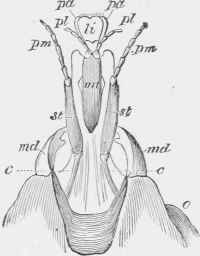
Fig. 12. - Front part of head of Prosopis, seen from below, with the mouth - parts extended, pa, paraglossae; li, ligula; pl, labial palpi; pm. maxillary palpi; mt, men-turn; st, stipes; md, man -dibles; c, cardo; o, eye.
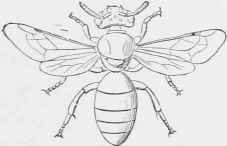
Fig. 13. - Prosopis.
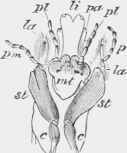
Fig. 14. - Mouth-parts of Polistes
Fig. 15.

Fig. 16.

Fig. 17.
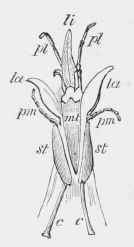

Fig. 18.

Fig. 19.
FiG. 15. - Mouth-parts of Andrena, seen from below - pa, paraglossse; li, ligula.; pl, labial palpi; pni, maxillary palpi; mt, mentum; si, stipes; c, cardo; 0, eye. Fig. 16. - Of Halictus. Fig. 17. - Of Panurgus. Fig. 18. - Of Halictoides. Fig. 19. - Of Chelostoma.

Fig 20. - Head of Humble-bee (Bombus agroruni), with the mouth-parts extended. pa, paraglossse; li, ligula; pl, labial palpi; pm, maxiliary palpi; la, lamina of ditto; mt, mentum; si, stipes; md, mandibles; c, cardo; o, eye.
If, again, we examine the hind-legs of bees, we shall find gradations similar to those already mentioned in the lower lip. In Prosopis (Fig. 21) they do not differ materially from those of genera which supply their young with animal food. Portions of the leg, indeed, bear stiff hairs, the original use of which, probably, was to clean these burrowing insects from particles of sand and earth, but which in Prosopis assist also in the collection of pollen.

Fig. 21.

Fig. 22.

Fig. 23.
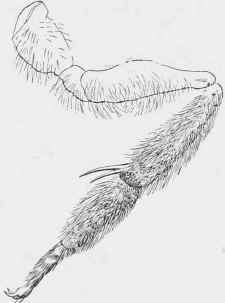
Fig. 24.
Fig. 21. - Left hind-leg of Prosopis. Fig. 22. - Left hind-leg of bphecodcs. Fig. 23. - Sphecodes. Fig. 24. - Right hind-leg of Hahetus.
Fig. 22 represents the hind leg of Sphecodes (Fig. 23), a genus in which the tongue resembles in form that of Halictus. Here we see the hairs decidedly more developed, a modification which has advanced still further in Halictus (Fig. 24), in which the development of the hairs is most marked on those segments of the hind legs which are most conveniently situated for the collection and transport of pollen. In Panurgus, the same change is still more marked (Fig. 25) and the pollen-bearing apparatus is confined to the tibia, and first segment of the tarsus, a differentiation which is even more apparent in Anthophora (Fig. 26). In all these bees the pollen is simply entangled in the hairs of the leg, as in a brush, but there are other genera, of which the humble bees and the hive bees are the only British representatives, which moisten the pollen with honey, and thus form it into a sticky mass, which is much more easy to carry, and is borne not round the leg, but on one side of it. In the Humble-bee (Bombus, Fig. 27) for instance, the honey is borne on the outer side of the hinder tibiae, which are flattened, smoothed, and bordered by a row of stiff curved hairs, thus forming a sort of little basket. Lastly in the Hive-bee (Fig. 28) the adaptation is still more complete, the hairs on the first tarsal segment are no longer scattered, but are arranged in regular rows, and the tibial spurs, inherited by Bombus from far distant ancestors, have entirely disappeared.

Fig. 25. - Left hind-leg of Pantirgus bariksianus.
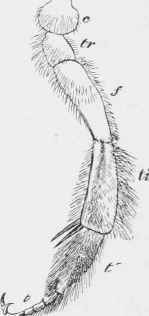
Fig. 26. - Right hind-leg of Anthophora bimaculata.
In some bees the pollen is collected on the body, and here also we find a remarkable gradation from Prosopis (Fig. 13) which has only simple hairs like a wasp; through Sphecodes and Nomada, in which the longer hairs are still few and generally simple (though some few are feathered); to Andrena and Halictus where the hairs are much more developed; a change which is still more marked in Saropoda, Colletes, and Megachile; still more so in Osmia and An-thophora; until we come to the Humble-bees, in which the whole body is covered with long feathered hairs.
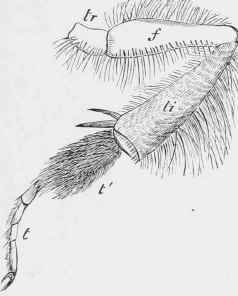
Continue to:


